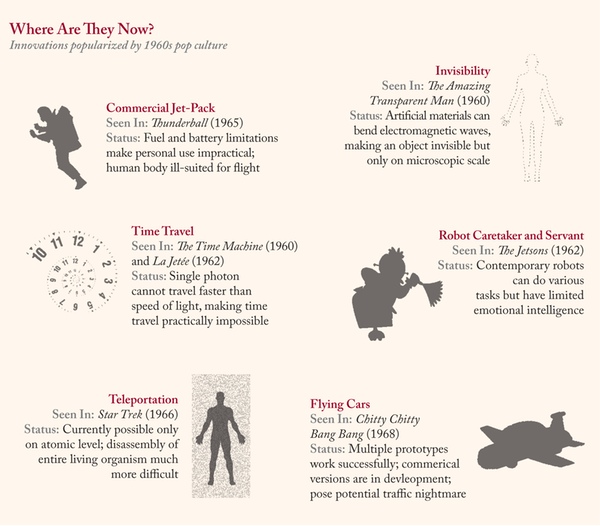October 2011 Archives

På 1960-talet flödade den teknologiska fantasin. Från Lapham's Quarterly.
Soundtrack: We Were Promised Jetpacks.
Findings, en samla-klipp-från-det-du-läser-tjänst som Steven B. Johnson varit med och grundat, och som har nämnts här tidigare, har nu öppnat för alla. Det går att importera sina markeringar från Kindle-böcker, liksom att använda sig av en bookmarklet för att få in klipp från vilken webbsida som helst.
Två av mina favorittjänster - Instapaper och Pinboard - omtalas i en Time-artikel om små internet-företag som vägrar att expandera.
The notion that companies must solicit investments and keep expanding in order to survive isn't always the goal anymore, especially during tough economic times. Web-based tools have helped level the playing field by lowering overhead costs so that a one-man operation can compete against million dollar corporations and thrive.
(Instapapers Marco Arments svar på frågan om vilken affärsmodell tjänster som Instapaper och Reability har, är en klassiker).
Några fascinerande saker från den senaste tiden:
- Forskare har lyckats använda accelerometern i en telefon för att gissa sig till vad man skriver på sin dator, om man har telefonen liggandes bredvid sig det vill säga. Wired Science:
The technique depends on the person typing at their computer with their mobile phone on the desk nearby. The vibrations created by typing onto the computer keyboard can be detected by the accelerometer of the phone and translated by a program into readable sentences with as much as 80 percent accuracy.
- En Lego Mindstorms NXT + en Samsung Galaxy SII lyckas lösa Rubiks kub på 5.35 sekunder.
- Svenska arméen beta-testar en fjärrstyrd rullande, sfärisk, allväders-robot med inbyggda kameror och ett "Augmented Reality User Interface". Producerad av Rotundus, mer hos BLDGBLOG.
Tre tumblers att följa: Fuck Yeah, Medical Stuff!, Biomedical Ephemera, or: A Frog for Your Boils och Scientific Illustration. Ganska ofta inget för den pjoskige.
Jag fick ett mail:
You are receiving this email because you had signed up at [xxx] some time over the past 9 years.While at its peak [xxx] was sending over 50,000 visitors a day to the blogs listed in its directory, severe mismanagement has led to the site decaying and becoming a shell of its former glory.
...och så läste jag ett tankvärt blogginlägg:
I feel sorry for blogging. How could something so great just wither on the vine? There are vast prairies of abandoned blogs now. Without any specific decision, there's been a mass migration to social networks, like tribesmen picking up and moving to cities overnight. It's certainly not the worst decision in internet history but maybe it's fair to say that it wasn't given much consideration at the time. [...] Progress isn't deliberated upon, it's magnetic. But once drawn in, you might find yourself living (in a shotgun shack) on a cheaply manufactured high-carb, high-fructose diet of realtime information. You've traded still pools of honest expression for rivers of pageviews and machine-generated timelines. It's not unreasonable to wonder whether we all made a little mistake with that.
En rätt fantastisk historia, som jag inte hört tidigare: om när den ungerska kemisten Georgy de Hevesy 1940 tog sig för att smälta ner lösa upp två stycken Nobel-medaljer (för Max von Laue och James Franke) i guld så att de ockuperande nazisterna inte skulle komma över dem:
On the day the Nazis came to Copenhagen, a Hungarian chemist named Georgy de Hevesy (he would one day win a Nobel of his own) was working in Bohr's lab. He wrote later, "I suggested that we should bury the medal(s)," but Bohr thought no, the Germans would dig up the grounds, the garden, search everywhere in the building. Too dangerous.So Hevesy's thoughts turned to chemistry. Maybe he could make the medals disappear. He took the first one, he says, and "I decided to dissolve it. While the invading forces marched in the streets of Copenhagen, I was busy dissolving Laue's and also James Franck's medals."This was not an obvious solution, since gold is a very stable element, doesn't tarnish, doesn't mix, and doesn't dissolve in anything -- except for one particular chemical emulsifier, called "aqua regia," a mixture of three parts hydrochloric acid and one part nitric acid.
An edition of Mary Shelley's Frankenstein laid out using characters and glyphs from PDF documents obtained through internet searches. The incomplete fonts found in the PDFs were reassembled into the text of Frankenstein based on their frequency of use. The most common characters are employed at the beginning of the book, and the text devolves into less common, more grotesque shapes and forms toward the end.
Påminner på något sätt om The Tree of Codes.
På temat "Hemma" har filmbolaget Lost & Found Films gjort ett par (så här långt) fina 5-minutare: den ovan om multimedia-konstnären Chon Gon Byun som bor i Boerum Hill, och sedan en om ferrotyp-fotografen John Coffer, som bor i en stuga som på 1800-talet. Se "This Must Be The Place".
| www.flickr.com |
Jag heter Erik Stattin och det här är min blogg. Jag skriver om digital kultur, ungefär. Du får gärna tipsa mig om saker. Kontakta mig på erik.stattin@gmail.com. Jag är mymarkup på Twitter och Pinboard.